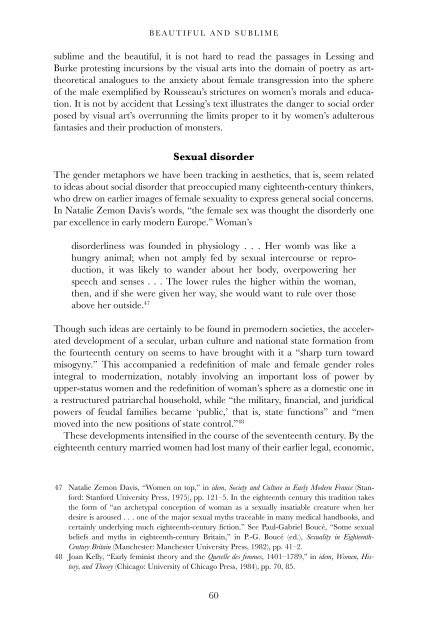Art in its Time: Theories and Practices of Modern Aesthetics
Art in its Time: Theories and Practices of Modern Aesthetics
Art in its Time: Theories and Practices of Modern Aesthetics
You also want an ePaper? Increase the reach of your titles
YUMPU automatically turns print PDFs into web optimized ePapers that Google loves.
BEAUTIFUL AND SUBLIME<br />
sublime <strong>and</strong> the beautiful, it is not hard to read the passages <strong>in</strong> Less<strong>in</strong>g <strong>and</strong><br />
Burke protest<strong>in</strong>g <strong>in</strong>cursions by the visual arts <strong>in</strong>to the doma<strong>in</strong> <strong>of</strong> poetry as arttheoretical<br />
analogues to the anxiety about female transgression <strong>in</strong>to the sphere<br />
<strong>of</strong> the male exemplified by Rousseau’s strictures on women’s morals <strong>and</strong> education.<br />
It is not by accident that Less<strong>in</strong>g’s text illustrates the danger to social order<br />
posed by visual art’s overrunn<strong>in</strong>g the lim<strong>its</strong> proper to it by women’s adulterous<br />
fantasies <strong>and</strong> their production <strong>of</strong> monsters.<br />
Sexual disorder<br />
The gender metaphors we have been track<strong>in</strong>g <strong>in</strong> aesthetics, that is, seem related<br />
to ideas about social disorder that preoccupied many eighteenth-century th<strong>in</strong>kers,<br />
who drew on earlier images <strong>of</strong> female sexuality to express general social concerns.<br />
In Natalie Zemon Davis’s words, “the female sex was thought the disorderly one<br />
par excellence <strong>in</strong> early modern Europe.” Woman’s<br />
disorderl<strong>in</strong>ess was founded <strong>in</strong> physiology . . . Her womb was like a<br />
hungry animal; when not amply fed by sexual <strong>in</strong>tercourse or reproduction,<br />
it was likely to w<strong>and</strong>er about her body, overpower<strong>in</strong>g her<br />
speech <strong>and</strong> senses . . . The lower rules the higher with<strong>in</strong> the woman,<br />
then, <strong>and</strong> if she were given her way, she would want to rule over those<br />
above her outside. 47<br />
Though such ideas are certa<strong>in</strong>ly to be found <strong>in</strong> premodern societies, the accelerated<br />
development <strong>of</strong> a secular, urban culture <strong>and</strong> national state formation from<br />
the fourteenth century on seems to have brought with it a “sharp turn toward<br />
misogyny.” This accompanied a redef<strong>in</strong>ition <strong>of</strong> male <strong>and</strong> female gender roles<br />
<strong>in</strong>tegral to modernization, notably <strong>in</strong>volv<strong>in</strong>g an important loss <strong>of</strong> power by<br />
upper-status women <strong>and</strong> the redef<strong>in</strong>ition <strong>of</strong> woman’s sphere as a domestic one <strong>in</strong><br />
a restructured patriarchal household, while “the military, f<strong>in</strong>ancial, <strong>and</strong> juridical<br />
powers <strong>of</strong> feudal families became ‘public,’ that is, state functions” <strong>and</strong> “men<br />
moved <strong>in</strong>to the new positions <strong>of</strong> state control.” 48<br />
These developments <strong>in</strong>tensified <strong>in</strong> the course <strong>of</strong> the seventeenth century. By the<br />
eighteenth century married women had lost many <strong>of</strong> their earlier legal, economic,<br />
47 Natalie Zemon Davis, “Women on top,” <strong>in</strong> idem, Society <strong>and</strong> Culture <strong>in</strong> Early <strong>Modern</strong> France (Stanford:<br />
Stanford University Press, 1975), pp. 121–5. In the eighteenth century this tradition takes<br />
the form <strong>of</strong> “an archetypal conception <strong>of</strong> woman as a sexually <strong>in</strong>satiable creature when her<br />
desire is aroused . . . one <strong>of</strong> the major sexual myths traceable <strong>in</strong> many medical h<strong>and</strong>books, <strong>and</strong><br />
certa<strong>in</strong>ly underly<strong>in</strong>g much eighteenth-century fiction.” See Paul-Gabriel Boucé, “Some sexual<br />
beliefs <strong>and</strong> myths <strong>in</strong> eighteenth-century Brita<strong>in</strong>,” <strong>in</strong> P.-G. Boucé (ed.), Sexuality <strong>in</strong> Eighteenth-<br />
Century Brita<strong>in</strong> (Manchester: Manchester University Press, 1982), pp. 41–2.<br />
48 Joan Kelly, “Early fem<strong>in</strong>ist theory <strong>and</strong> the Querelle des femmes, 1401–1789,” <strong>in</strong> idem, Women, History,<br />
<strong>and</strong> Theory (Chicago: University <strong>of</strong> Chicago Press, 1984), pp. 70, 85.<br />
60
















